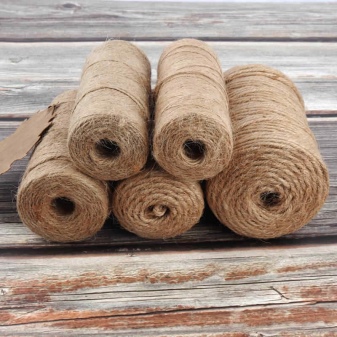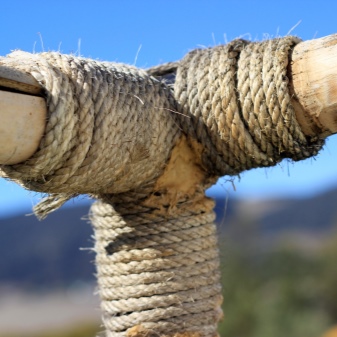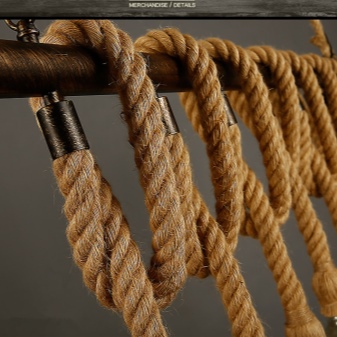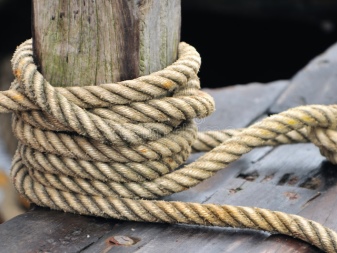All about hemp ropes

Hemp ropes are products made from flax and hemp fibers. They are manufactured in strict accordance with GOST 30055-93.


What is it and what is it made of?
The range of products is quite extensive, because they can be from 10 mm to 8 cm in diameter, while the circumference will be no more than 25 cm. In such a rope there is a harmonious symbiosis of the softness of flax and the reliability of hemp. It is best if their combination in a product is a 1: 1 ratio. Hemp is not afraid of the sun's rays or thermal radiation, it does not accumulate static electricity, it is absolutely natural, which means it is environmentally friendly.
Both flax and hemp ropes tend to elongate by 10% if they are constantly stressed.
The product has a specific gravity of 1.38%. The weight of a running meter of a rope depends on its diameter, as well as on whether it is white or tarred. Accordingly, a meter of cable with a diameter of 16 mm will be lighter than a meter of the same cable with a diameter of 20 mm.


There are drawbacks to products made from hemp and flax. This is soaking, water absorption. Since the amount of water absorbed can be large, the rope may start to rot. A wet product has a reduced breaking load, the more moisture is absorbed, the lower the strength. This is most often found in those ropes for the manufacture of which a cable lay was used. To avoid this, it is necessary to provide a dry and cool storage area for hemp products.
The production of hemp ropes is carried out by means of a three-strand lay. Each of the strands, in turn, is also twisted. For the manufacture of strands, bobbins are used - long (not short) threads of hemp fiber. Fiber, in turn, is derived from hemp. A rope can be assigned to one of the groups:
- special;
- increased;
- ordinary.
As for the driving rope, it can only be whitewashed.

Species overview
Hemp ropes and cables are used as braces and slings in case of lifting a load of light weight. Although such products are lighter than steel ropes, they have a lower breaking load.
Hemp ropes can be resin (which means they are impregnated with hot resin) and whitewash (they are not impregnated with anything). To choose an impregnated product or not depends on the needs for which it will be used.
The classification of ropes is made on different grounds, the main of which is diameter. The nominal diameter is the one that is obtained as a result of the description of a circle around the cross section of the strands of the rope. In accordance with this parameter, the following categories are distinguished:
- line - with a diameter less than the nominal;
- cable - its diameter ranges from 1 to 4 nominal;
- perlin - a fork of diameters for this rope is 100–152 mm, that is, 4–6 nominal diameters;
- hemp cable rope is the thickest, its diameter is 152–330 mm.

The type of weaving also divides all the ropes into 2 large groups: having a straight descent of strands and a reverse one. By the number of weaving strands, products can be distinguished:
- two-strand;
- three-strand;
- four-strand.
The reliability of the product directly depends on how many strands are used to weave it. Pitched rope is perfect, for example, to insulate a wooden building. It is placed between the logs.
The raw material used to make the ropes is very important, especially as a pricing factor. The rope can be ordinary or barbed. The price of the products will vary.


Nuances of choice
When choosing a product, it is necessary to be guided primarily by the needs for which it will be used. If this is a decor, then it is allowed to simply choose those ropes that you like and match the color scheme. If you plan to use the product for loads, you must take into account such an indicator as the safety factor. It must be at least 8. It is calculated using a special formula. And you will also need to know the breaking force of the product.


Applications
Hemp rope products have more than a wide range of applications. For industrial and construction purposes, they are used to carry or hold loads at a height as one of the components of cargo slings. The oil and gas industry widely uses ropes, they are indispensable for drilling rigs (this applies to such types of drilling as exploration and production percussion rope). Maritime business cannot do without hemp ropes, because in salt water they do not lose their original shape, do not rot and retain their operational properties for a long time.
Interestingly, a hemp rope can be the centerpiece of a steel rope.



Recently, ropes and cables have been widely used as decorative elements. But in this vein, they began to be applied relatively recently. The marine style in the interior and landscape looks fresh and stylish, and a hemp rope is an indispensable attribute for decorating many items: benches, mirrors, stair railings, chairs. It can be used to wrap a post or decorate steps, even decorate a log cabin made of wood. Due to their naturalness and environmental friendliness, the ropes are safe for humans, therefore they can be part of any decor, even a children's room. For outdoor use (for example, when decorating benches, gazebos, lanterns, poles), you need to take care of the impregnation of products from decay, especially if they are exposed to precipitation or will be in direct contact with the ground.

The unconventional use of hemp ropes as a means for sealing the seams between the crowns of a log house has become very popular. In fact, this is quite understandable, because it is hemp rope in its characteristics that can compete with traditional heaters, and with construction or linen tow.
The diameter of the rope, with which it is planned to insulate the crowns, is selected based on how thick the gaps between the logs are.

Comparison with other types of ropes
In comparison with jute rope, hemp is definitely inferior in terms of external characteristics. The jute product has an original and attractive appearance. But Since jute is not grown in the Russian Federation, and hemp, which serves as a raw material for hemp ropes, is grown, you need to understand that hemp products are much cheaper. If we talk about use in the fleet, then it is hemp that is less susceptible to the effects of salt water and copes well with the applied loads. As for the differences in the naturalness of the composition, they are absent. Both jute and hemp are environmentally friendly materials, like products made from them.








The comment was sent successfully.